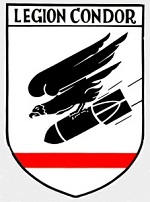Corgi AA33711 German Heinkel He 111H-3 Medium Bomber - Kampfgeschwader 53 'Legion Condor', Lille-Nord, France, Summer 1940 (1:72 Scale)
"Guns before butter. Guns will make us powerful; butter will only make us fat."
- Reichsmarschall Hermann Goering, Head of the German Luftwaffe
 When World War I ended, the German Air Force was disbanded under the Treaty of Versailles, which required the German government to abandon all military aviation by October 1st, 1919. However, by 1922, it was legal for Germany to design and manufacture commercial aircraft, and one of the first modern medium bombers to emerge from this process was the Heinkel He 111, the first prototype of which an enlarged, twin-engine version of the single-engine mail-liaison He 70, which set 8 world speed records in 1933 flew in February of 1935. The second prototype, the He 111 V2, had shorter wings and was the first civil transport prototype, capable of carrying 10 passengers and mail. The third prototype, He 111 V3 also had shorter wings and was the first true bomber prototype. Six He 111 C series airliners were derived from the fourth prototype, the He 111 V4, and went into service with Lufthansa in 1936, powered by a variety of engines, including BMW 132 radials. The first production models had the classic stepped windshield and an elliptical wing, which the designers, Siegfried and Walter Gunter, favored.
When World War I ended, the German Air Force was disbanded under the Treaty of Versailles, which required the German government to abandon all military aviation by October 1st, 1919. However, by 1922, it was legal for Germany to design and manufacture commercial aircraft, and one of the first modern medium bombers to emerge from this process was the Heinkel He 111, the first prototype of which an enlarged, twin-engine version of the single-engine mail-liaison He 70, which set 8 world speed records in 1933 flew in February of 1935. The second prototype, the He 111 V2, had shorter wings and was the first civil transport prototype, capable of carrying 10 passengers and mail. The third prototype, He 111 V3 also had shorter wings and was the first true bomber prototype. Six He 111 C series airliners were derived from the fourth prototype, the He 111 V4, and went into service with Lufthansa in 1936, powered by a variety of engines, including BMW 132 radials. The first production models had the classic stepped windshield and an elliptical wing, which the designers, Siegfried and Walter Gunter, favored.
As a military aircraft, it took longer to gain favor, because military load requirements and underpowered engines kept its cruising speed down to less than 170 mph. However, in early 1936, the plane was given 1,000 hp Daimler Benz DB 600A engines which improved performance dramatically enough to bring in substantial orders. The first two mass-production versions, He 111 E and He 111 F experienced great success during the Spanish Civil War, where they served with the Condor Legion as fast bombers, able to outrun many of the fighters sent against them.
In fact, the experience in Spain generated a false sense of security in which the Germans thought that the He 111's light armament and speed would be sufficient in the coming war. Thus, although it was out of date, the large numbers in which it had been produced made the He 111 the Luftwaffe's primary bomber for far too long in the war, availability being more persuasive than practicality for this serviceable, but highly vulnerable, aircraft. Modern fighters like the Supermarine Spitfire and the Hawker Hurricane proved the He 111's inadequacy during the Battle of Britain. As soon as possible, the Luftwaffe replaced the Heinkel with the Junkers Ju 88, reassigning the Heinkel to night operations and other specialized tasks until, by war's end, it was being used primarily as a transport.
Pictured here is a 1:72 scale replica of a German Heinkel He 111H-3 medium bomber that was attached to Kampfgeschwader 53 'Condorlegion', then deployed to Lille-Nord, France, during the summer of 1940.
Sold Out!
Dimensions:
Wingspan: 12-1/2-inches
Length: 9-inches
Release Date: December 2008
 Historical Account: "Day of the Condor" - Kampfgeschwader 53 "Legion Condor" (KG 53) was a Luftwaffe bomber wing during World War II. Its units participated on all of the fronts in the European Theatre until it was disbanded in May 1945. It operated three of the major German bomber types: the Dornier Do 17, Heinkel He 111 and the Junkers Ju 88.
Historical Account: "Day of the Condor" - Kampfgeschwader 53 "Legion Condor" (KG 53) was a Luftwaffe bomber wing during World War II. Its units participated on all of the fronts in the European Theatre until it was disbanded in May 1945. It operated three of the major German bomber types: the Dornier Do 17, Heinkel He 111 and the Junkers Ju 88.
During the invasion of France and the Low Countries, I./KG 53 flew support missions against supply and rail targets in the Reims area. Later targets in Abbeville, Amiens, Rouen and Arras were attacked. I./KG 53 recorded zero losses in the first two days. II./KG had 36 He 111s on strength and participated at the Sedan breakthrough, attacking targets around Lille, and supported I./KG 53.


